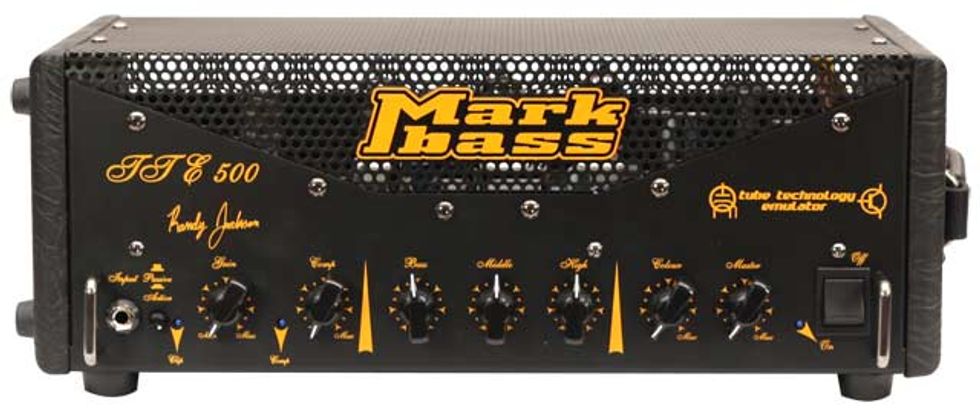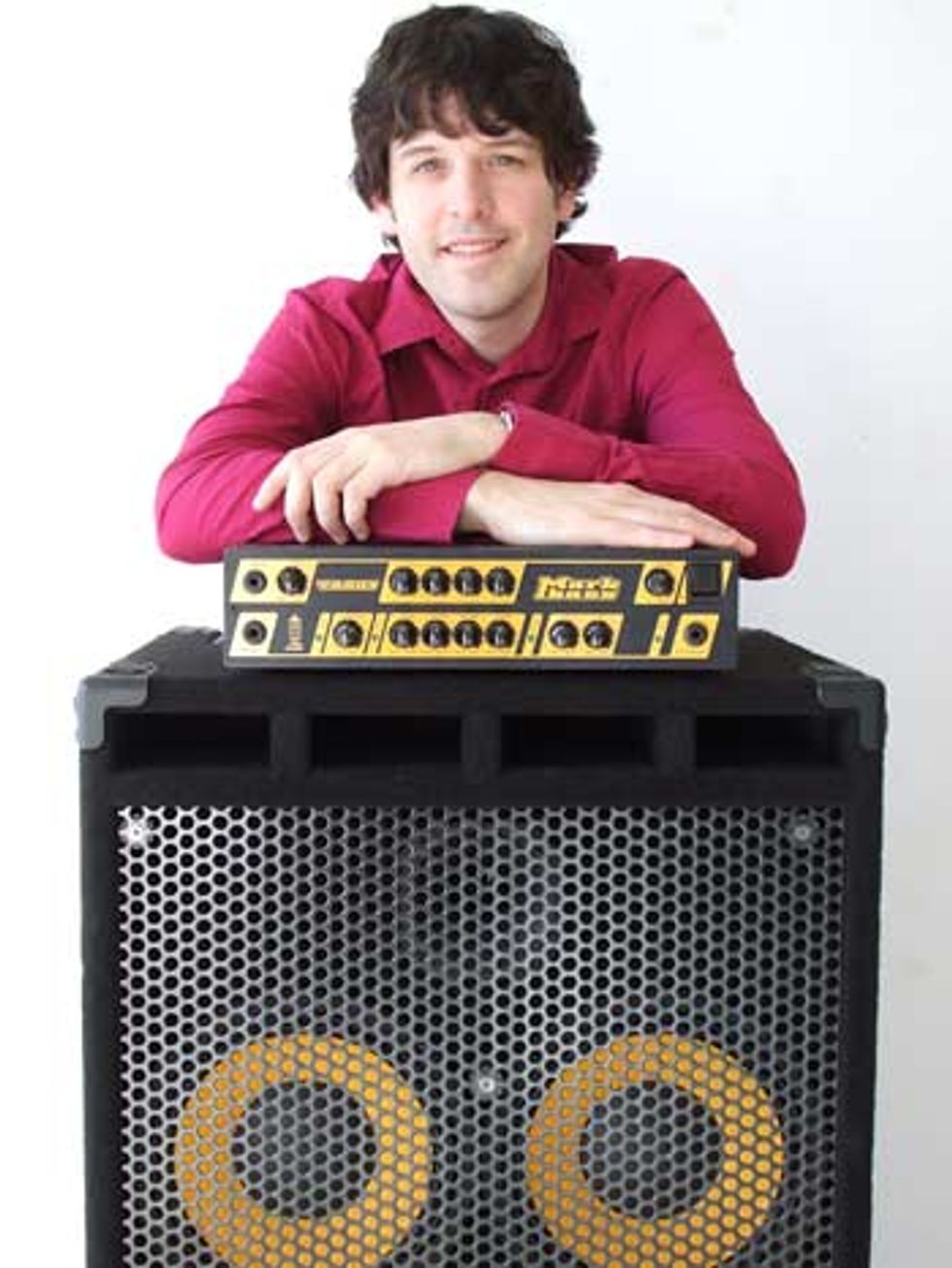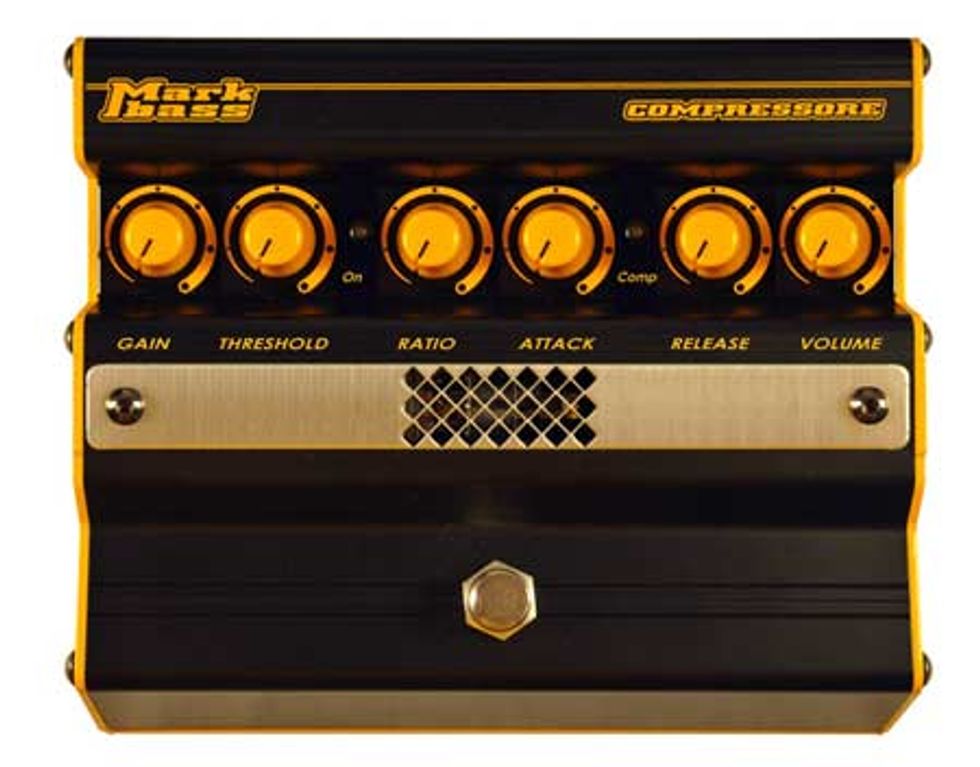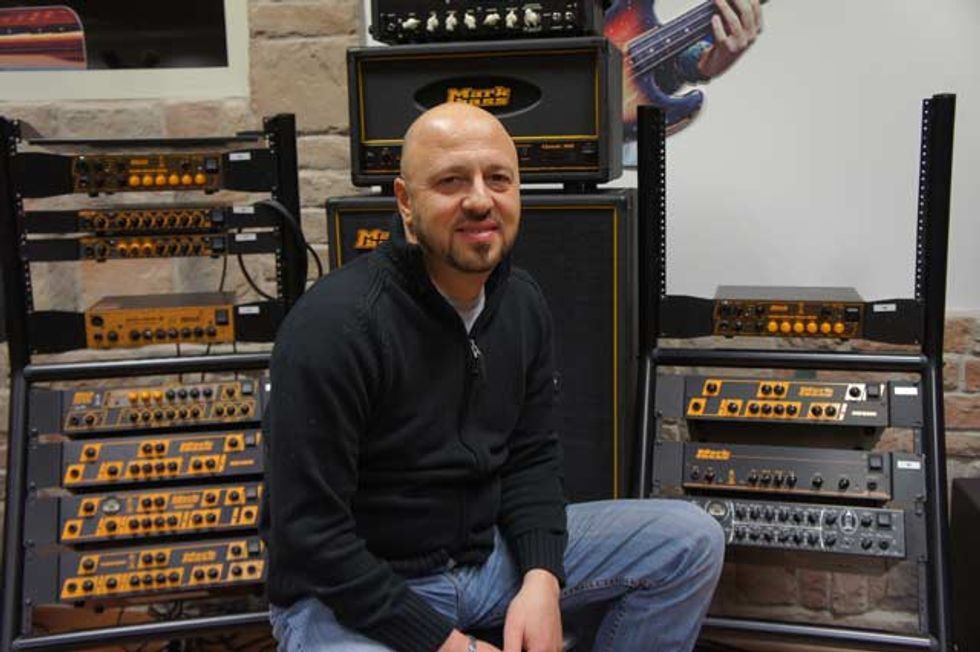Markbass is an Italian company best known for its lightweight bass amps and speaker cabs, all with distinctive yellow accents. Its founder, Marco De Virgiliis, surprisingly identifies musically as a sax player, though he does enjoy dabbling in occasional electric bass work. Early on, De Virgiliis studied electronic engineering and worked in the telecommunications field while developing his bass amplification designs. During a fateful jam session with friends many years ago, a bassist was impressed by the sound of an amp De Virgiliis had built, and asked him if he could buy it. Then another friend asked for one, and another and another. The roots of Markbass were planted, though not yet by that name.
In the early ’90s, De Virgiliis launched a brand called Parsek. After refining designs for several years, he then entered into a partnership with Ernie Ball and created a 500-watt amp head along with 210 and 212, cabs under the name Audiophile. The amps were well received by the bass playing community, but the brand was short-lived and Ernie Ball sold off the remaining amps at bargain-basement prices. It was also during this period that De Virgiliis pioneered the use of neodymium speakers for bass enclosures, through a partnership with Italy’s B&C Speakers. Neodymium magnet speakers—now part of almost every manufacturer’s product line—dropped the weight of bass speakers radically. Though they initially had a few bugs to work out, neo cabs are now widely accepted, and bassists’ backs are certainly appreciative.
After a couple more years of R&D, De Virgiliis launched Markbass in 2001. Now celebrating its 10th anniversary, the Markbass brand is best known for its Little Mark series of amps, anchored by the 6.39 pound, 500-watt (at 4 Ω) Little Mark III. But Markbass offers a variety of other bass amps and cabs, and recently, the company introduced a line of effects pedals and a series of guitar amps and cabs.
Peter Murray, who handles international promotion, marketing, and artist relations for Markbass, is an active professional bassist working in Toronto, Canada. He became the first Canadian Markbass endorser in 2003, and soon noticed the company needed some help from a native English speaker for its North American marketing efforts. Murray initially offered to help out on a short-term basis, but after meeting Marco and the Markbass team at the 2005 NAMM show, he began working with the company in a more formal role.
Premier Guitar caught up with Marco and Peter after a whirlwind season of tradeshows, including the recent Musikmesse 2011 in Germany.
Can you describe Markbass in three words?
De Virgiliis: Tone, reliability, lightweight.
Most bass amps have a signature sound. How would you describe the sound of Markbass gear?
De Virgiliis: Markbass products are known for their clarity and loyalty to the source sound—reproducing the natural sound of your instrument. That said, they never sound sterile. People often use words like warm, punchy, clear, honest, accurate, and aggressive. They also say Markbass amps allow them to sound like themselves.
Markbass’ black and yellow color scheme really stands out. What led to that color choice?
De Virgiliis: Bassists have been stuck with black, silver, and grey for their equipment. I chose a color that could give bassists more visibility on stage, and they appreciated that immediately. Yellow has been one of my preferred colors and it’s now a distinctive part of the brand. Of course, the color is not the main mission of Markbass, which is designing and manufacturing top quality products at a competitive and honest price.
What’s it like in your factory?
De Virgiliis: The air that our company breathes is made up of teamwork, enthusiasm, and passion. All of our products are born into a very happy home! Over the years this has always been one of our greatest advantages. Every single technician who plays a role in assembly, testing, and packaging is trained to be an expert at what he does, and is treated with full respect for his human and employee rights. At the end of the work day, they share their free time together—playing and joking around—but still find themselves talking about amplifiers!
Your website shows several heads in the Markbass line, including the Little Mark. How have you settled on these models? How do the F Series amps compare to the Little Mark gear?
De Virgiliis: Without a doubt, the Little Mark series is our most popular line, although the whole line of heads has sold well for us. The Little Mark II's legacy was largely secured by the amp's compact size, lightweight, and warm, natural sound. These characteristics have been preserved in the whole family of Little Mark heads, along with the addition of some frequently requested features.
F Series amps are also popular—smaller in size and ultra-lightweight making them ready to go anywhere—but still having the big tone of the Little Mark.
Murray: In addition to being half the size of the Little Mark, the F Series possesses digital power amps that provide a very clear, crisp sound, and a fast response. The 500-watt Little Mark, in contrast, has an analog power amp.

This F1 is part of Markbass' F Series, which features ultra-compact enclosures and digital power amps.
How did you come up with the VPF (Variable Pre-shape Filter) and VLE (Vintage Loudspeaker Emulator) controls?
De Virgiliis: The VPF and VLE filters are very useful—let me say “magic”—they’re a quick way of setting the tone, from vintage to modern hi-fi sound without adjusting the EQ section. For many Markbass amp users, the VLE and VPF filters are the only knobs they turn.
Markbass also offers three heads that depart from the Little Mark design. Most recently, the TTE 500 (with a tube preamp), but also the ultra-high wattage SD1200, and the all-tube Classic 300. What led to them?
De Virgiliis: I have always collaborated closely with top Markbass endorsers and listened carefully to their precious suggestions. Randy Jackson’s collaboration was invaluable for the TTE 500 we introduced at Musikmesse 2011. The TTE 500 stands out from the rest of the Markbass amp lineup with a very cool “modern vintage” design. Contemporary technology is brought together with classic tone concepts in a head that looks and sounds vintage.

Randy Jackson signature TTE 500 head
The TTE 500 also features some special adaptations of the Markbass innovations that put the brand on the map. The sound comes into this beauty through an old style tube preamp and then fed through a tube compressor. From there it goes into a simple 3-band passive EQ section, a “Colour” filter (a tube adaptation of the famous Markbass VLE), and then finally gets amplified by an innovative Tube Technology Emulator power amp.
Murray: The Tube Technology Emulator power amp is an analog design that sounds more like a tube power amp—very unique!
How did Markbass develop the modular MoMark head that lets users customize their amp controls? Any new modules in the works?
De Virgiliis: Throughout history, many of our Italian forefathers gave free play to their creativity, unconstrained by existing standards and conventions. More importantly, they were driven to think in a lateral way. They were fearless—daring to look beyond the common way of doing things—and more interested in pushing the limits of their ingenuity. We applied this kind of lateral thinking to the MoMark project in a free, positive, and creative way. This is the cornerstone of our philosophy in work and life. And it’s from this approach, this attitude, this philosophy, and this spirit that MoMark was born.
Murray: Many bass players are excited that the MoMark allows them to create the amp they want, using the components, features, and power they choose. The MoMark gives bass players the option to change those choices at any time without buying a whole new amp.
De Virgiliis: As far as new modules, we just introduced the MVVL-HE high-end master module and we are working on new modules following all the feedback and suggestions from MoMark users.
 Markbass' Peter Murray rests atop a TA503, one of the company's 500-watt heads. |
De Virgiliis: Like the other Markbass products, our cabinets faithfully reproduce the sound of any instrument played through them. The range of speakers, tuned port configurations, and sonic character give our users a wide range of options to meet their tastes and needs.
Murray: Markbass cabinets are designed to give bassists the real sound of their instrument within the context of a loud band on a gig—that’s when they really shine—when you really hear their full potential. Many other cabinets will sound great in the store or the bedroom, but won’t survive when on a loud gig.
Markbass has designed six combo amps, from the under-30 pound Mini CMD 121P, to the CMD 103H (three 10" speakers and a horn). What is the connection between the Markbass combo amps and the separate heads and cabs?
De Virgiliis: Markbass combos are made using the same cutting edge technology and top quality components as the heads and cabinets. Some manufacturers treat combos as amps for beginners, but there are no corners cut here, and the same quality standards apply to all of our products.
Murray: The CMD and Mini CMD series combos include the Little Mark III in them, as well as the same components and materials we use for our cabinets. The quality level is the same as if you were using separate heads and cabinets.
Markbass has introduced some new effects pedals. How do Markbass pedals stand out from other pedals on the market, aside from their distinctive colors?
De Virgiliis: It was inevitable for a brand like Markbass to complete our product line with effect pedals. Of course, as I mentioned, the distinctive colors are not the important thing. I prefer to talk about how proud we are about the high quality standard we’re able to offer thanks to our 100% made-in-Italy production. Our Markbass Pedal Controller software allows a user to customize their presets on our digital pedals, including the Super Synth, Chorus/Flanger, and Riverbero. The Compressore—a high-quality tube compressor—features all the individual controls normally found on professional studio outboard compressors.
Murray: People tell us all the time that it sounds as good as the larger studio compressors that cost thousands of dollars.

Markbass Compressore
The DV Mark line of guitar amps, cabs, combos and pedals is yet another new direction for Markbass. How does this gear stand out from the abundance of guitar equipment already out there?
De Virgiliis: DV Mark was founded on the same design and production concepts that made Markbass one of the top amplifier brands in the world. After years of research and development, and consultation with some of the world’s best guitarists, I was ready to start on guitar amplification. Yes, there is an abundance of guitar equipment already, but much of it lacks reliability and versatility. In DV Mark, technology and innovation are blended with a profound respect for the great history and traditions of the classic guitar amps. We have several patent-pending features that offer killer tone, extreme reliability, light weight, great versatility, cool design and excellent value. As for Markbass, I started the design, and with my team we developed the products into what they are.
Murray: The response to DV Mark products so far has been extremely positive! It’s been a very encouraging start.
Very few European companies have broken into the U.S. bass amplification market in a big way like Markbass. How does your U.S. marketing strategy differ from your European sales approach?
De Virgiliis: I don’t think our success in the U.S. is related to a different marketing strategy. It is the same worldwide, with a philosophy that gives top priority to the needs and desires of bass players. State of the art technology, innovative production methods, Italian manufacturing, and our relationships with end users who recognize how serious and impassioned our staff are. We get thousands of emails testifying to our unique and friendly work style.
What’s next for Markbass in this tough economic climate?
De Virgiliis: Despite the economic climate, I think that the only way to maintain the growth and worldwide success of Markbass is to keep manufacturing in Italy. We control the entire process, from the quality of our materials to our rigorous testing procedures. For now we stand firm on this, despite the fact that so many other companies have moved their production to Asia, seduced by the short-term economic benefits of lower production costs.
Not only does manufacturing in Italy keep our quality control strong—it also allows us to innovate quickly and continuously. With an offshore factory, we’d be locked into inflexible and long-term production schedules. Our products can’t afford this type of inflexibility! We’re a company with vision, passion, and an irrepressible drive to innovate. In addition, we place a high value on human resources and consider factors such as human rights and the environment in all our decisions.







![Rig Rundown: AFI [2025]](https://www.premierguitar.com/media-library/youtube.jpg?id=62064741&width=1245&height=700&quality=70&coordinates=0%2C0%2C0%2C0)












 Shop Scott's Rig
Shop Scott's Rig
![Rig Rundown: Russian Circles’ Mike Sullivan [2025]](https://www.premierguitar.com/media-library/youtube.jpg?id=62303631&width=1245&height=700&quality=70&coordinates=0%2C0%2C0%2C0)














































